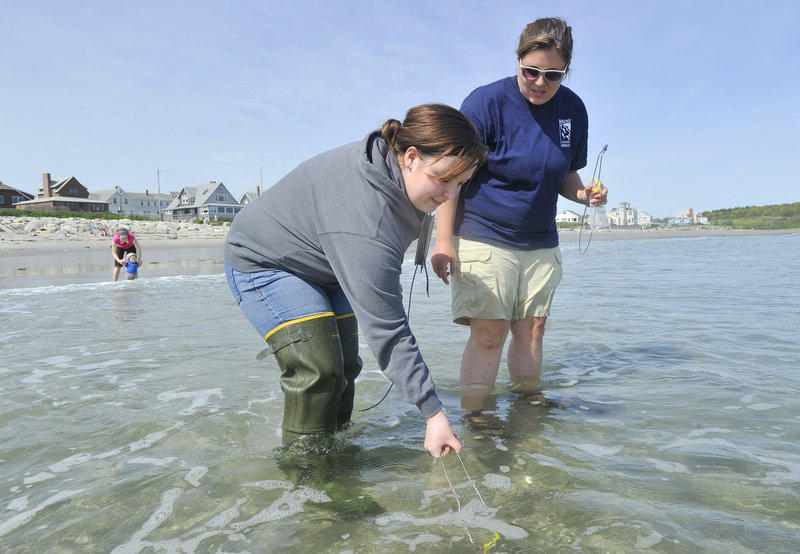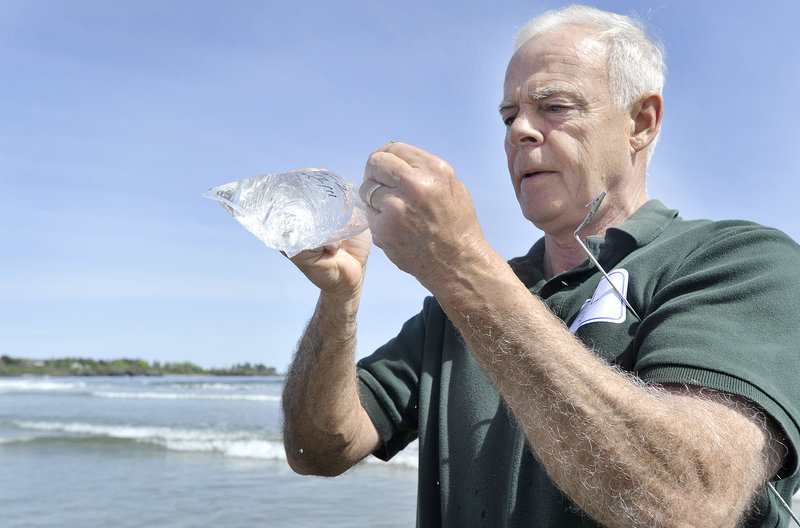SCARBOROUGH – With green waders pulled up over her jeans, Becca Carifio walked off Bayview Avenue and down the granite steps to Higgins Beach on Wednesday afternoon.
The Scarborough High School senior, along with eight other volunteer beach monitors, watched as instructors Keri Lindberg and Sarah Mosley showed them how to record air and surf conditions properly, and to scan for potential bacteria sources like dogs or kids in diapers.
Then, the group walked down into the waves to collect the first water quality samples of the swimming season.
“I live here, so this is a good opportunity for me to help take care of the area,” said Carifio, who grew up swimming at Higgins Beach and is one of four high school students who are volunteer monitors this summer.
“It’s like I’m keeping the magic of the neighborhood alive,” she said.
From now until Labor Day, here at Higgins and at nearly 60 other beaches across the state, volunteers trained by the Maine Healthy Beaches program will gather data to help protect public safety and map out areas where pollution needs to be reduced.
“By the end of June we will have trained almost 200 people. There’s no way we could do this important work without them,” said Lindberg, who works for the University of Maine Cooperative Extension and coordinates the Healthy Beaches program.
In its pilot season, 2002, the program monitored two beaches. Now, with annual funding of about $250,000 from the U.S. Environmental Protection Agency, the program monitors water quality at beaches from Kittery to Mount Desert Island.
It looks specifically at levels of fecal bacteria, which can come from a variety of sources, including polluted storm water runoff, untreated boat sewage, animal waste, sewage treatment plant overflows and malfunctioning septic systems.
When bacteria levels exceed the EPA safety limit, beaches may be posted with advisories to caution swimmers. The advisories are posted at beach access points and on the Maine Healthy Beaches website.
In 2010, there were 207 advisories issued at 29 coastal beach areas in Maine. The number was down from 250 in 2009, when there was more rainfall during the swimming season.
Five beach areas — Goose Rocks in Kennebunkport, Little in Ogunquit, Riverside in Ogunquit, Goodies in Rockport and Short Sands in York — accounted for nearly half of the reported beach advisories in 2010. All of those areas are affected significantly by the mouths of rivers and streams, which bring bacteria to the beaches, Lindberg said.
High levels of fecal contamination can cause waterborne illness, symptoms of which can include nausea, diarrhea, stomach cramps, chills and fever.
“Local partnerships are key,” said Lindberg, who works with municipal beach managers, state and national park staffers, and people like Glennis Chabot with the Higgins Beach Association.
“Typically, our beaches are public beaches,” Lindberg said. “Higgins Beach is private, but they have a management entity, and Glennis is willing to take on this management role. They don’t have to do this, it’s a voluntary program. Many other beaches that are privately owned do not participate.”
Chabot, who has been the point person for the monitoring of Higgins Beach for five years, said she is particularly excited to see participation by Scarborough High School students Carifio, Sam Vachon and Meg Kirsch, as well as Ceile Day, a Scarborough resident who goes to Cheverus High School.
“I’m hoping that this will be a yearly thing. It’s certainly a good education for them,” Chabot said.
The ultimate goal of the Healthy Beaches Program is to cut down on the number of advisories, by analyzing the data and pinpointing sources of contaminants. Intensive outreach and cooperation with various agencies has helped bring bacteria levels down at Goose Rocks Beach and at Camden Harbor, Lindberg said, noting two success stories.
“It’s more than just beach monitoring,” Lindberg said. “We’re not just going to identify the problem, we’re going to ask, ‘Where is the problem coming from, and how can we fix it.’ “
Staff writer Trevor Maxwell can be contacted at 791-6451 or at:
tmaxwell@pressherald.com
Copy the Story Link
Send questions/comments to the editors.




Success. Please wait for the page to reload. If the page does not reload within 5 seconds, please refresh the page.
Enter your email and password to access comments.
Hi, to comment on stories you must . This profile is in addition to your subscription and website login.
Already have a commenting profile? .
Invalid username/password.
Please check your email to confirm and complete your registration.
Only subscribers are eligible to post comments. Please subscribe or login first for digital access. Here’s why.
Use the form below to reset your password. When you've submitted your account email, we will send an email with a reset code.